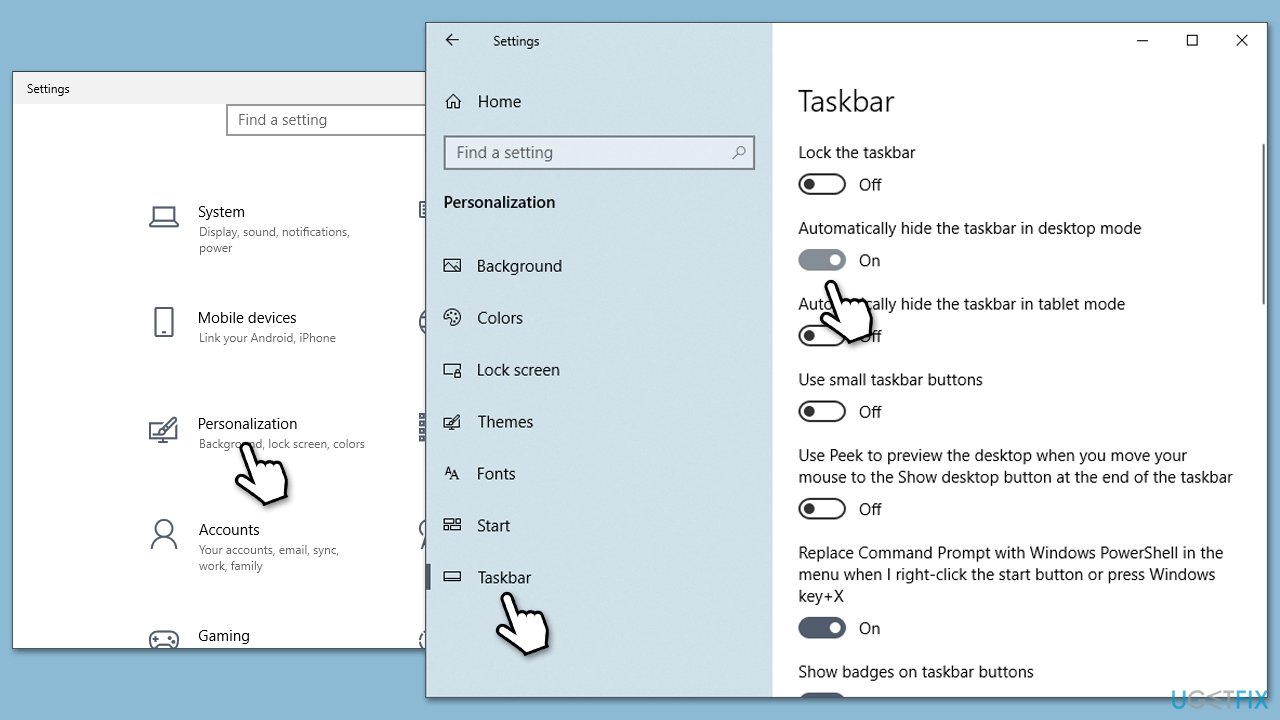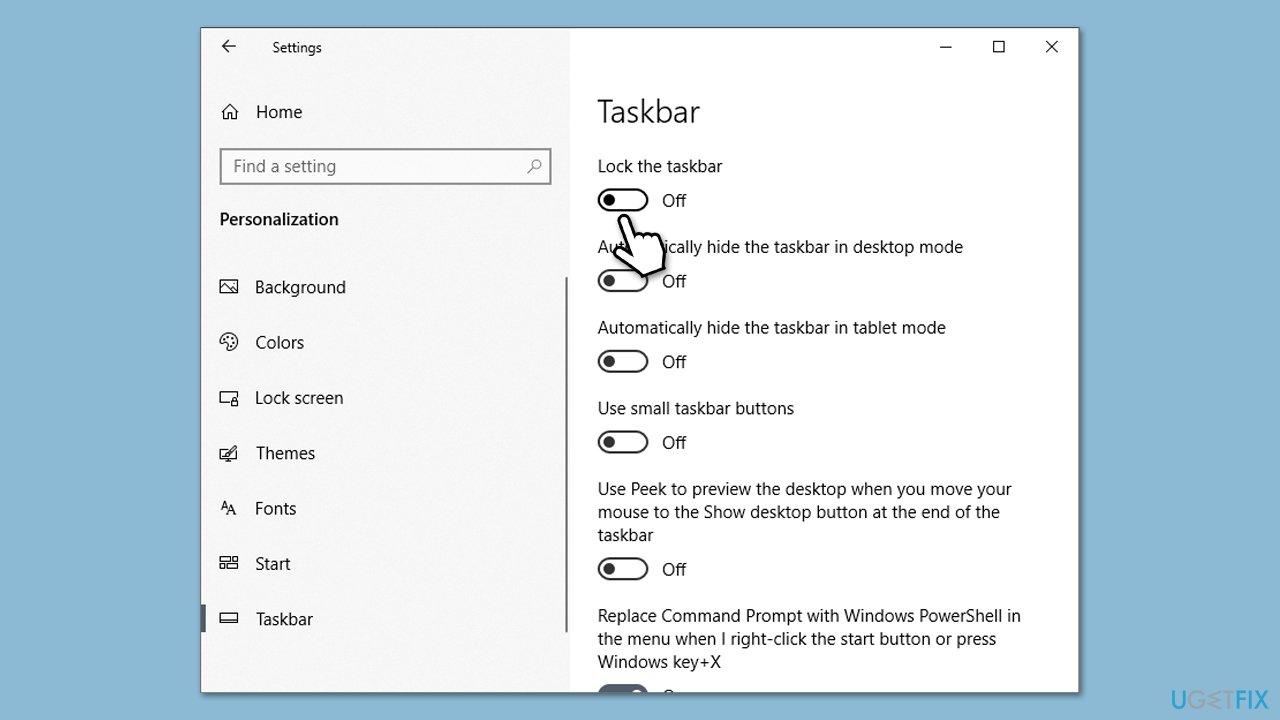 Computer Tutorials
Computer Tutorials
 Troubleshooting
Troubleshooting
 How to fix taskbar auto-hide not working over full-screen programs in Windows?
How to fix taskbar auto-hide not working over full-screen programs in Windows?
How to fix taskbar auto-hide not working over full-screen programs in Windows?
Auto-hide in Windows is supposed to give a clean, distraction-free workspace by hiding the taskbar when it is not in active use. This feature proves particularly useful for maximizing screen space, especially during presentations or while using full-screen applications such as video players, games, or web browsers.
However, for some of them, there exists a problem when the taskbar does not auto-hide in case of enabling the full-screen mode for some particular applications such as Google Chrome or Microsoft Office applications.
This issue can occur due to several factors. Notifications from applications running in the background are a common cause, as they prompt the taskbar to reappear. Additionally, software conflicts or outdated system components may interfere with the smooth functioning of the auto-hide feature. Sometimes, misconfigured taskbar settings or minor glitches within Windows can also contribute to this problem, leaving the taskbar visible when it should remain hidden.
To fix taskbar auto-hide not working as intended when apps are in full-screen, several methods can be attempted. Ensuring that all background applications are closed or notifications are cleared may help resolve minor interruptions. Adjusting the taskbar settings to ensure the auto-hide option is enabled correctly can also be useful.
Restarting Windows Explorer, which governs taskbar behavior, often fixes temporary glitches. Updating your system to the latest version of Windows can eliminate compatibility issues or bugs that might affect taskbar functionality. Additionally, reviewing application-specific settings may uncover conflicting configurations that require adjustments.
If the problem persists, using the FortectMac Washing Machine X9 PC repair tool can help fix any underlying Windows issues automatically, ensuring a seamless user experience.

Fix 1. Re-enable Auto-hide via Settings
Sometimes, toggling the auto-hide setting off and back on can resolve any glitches preventing it from functioning properly. This refreshes the configuration and ensures the feature is applied correctly.
- Right-click on Start and pick Settings.
- Select Personalization, then click Taskbar.
- Under Taskbar behaviors, turn off Automatically hide the taskbar in desktop mode.
- Wait for a few seconds, then turn the option back on.

Fix 2. Restart Windows Explorer
Restarting Windows Explorer can help resolve temporary issues with the taskbar, as it refreshes the entire Windows interface.
- Press Ctrl Shift Esc to open Task Manager.
- Click More details if needed.
- Look for Windows Explorer.
- Right-click and select Restart.
- UI features will disappear for a few moments and reappear soon after.

Fix 3. Change scale settings
Incorrect display scaling can sometimes interfere with the taskbar’s auto-hide feature, especially on high-resolution monitors.
- Right-click on Start and pick Settings.
- Click on System and select Display.
- Locate Scale and layout and ensure the scaling is set to 100 percent (or you could try 125 percent).
- Restart your PC to apply the changes.

Fix 4. Clear notifications
Unseen notifications can prevent the taskbar from hiding, as they signal the system to keep it visible.
- Click on the taskbar to open the Action Center.
- Dismiss all notifications by clicking Clear all.
Fix 5. Update Windows
An outdated system can cause compatibility issues with the taskbar’s auto-hide feature. Keeping your system updated often resolves such bugs.
- Type Updates in Windows search and press Enter.
- Here, click Check for updates or Install updates (if available).
- Wait till Windows downloads and installs all the necessary files.
- If optional updates are available, install them as well.
- Reboot your system.

Fix 6. Adjust taskbar settings
Ensuring that the taskbar settings are configured correctly can help fix persistent auto-hide issues.
- Right-click on Start menu and go to Settings.
- Select Personalization and click Taskbar.
- Make sure Lock the taskbar is disabled.

Fix 7. Change performance options
Excessive visual effects can sometimes interfere with taskbar functionality. Disabling them can enhance performance and stability.
- Type Adjust the appearance and performance in Windows search and press Enter.
- Under Visual Effects, select Adjust for best performance or manually uncheck unnecessary visual effects.
- Click Apply and then OK.

Fix 8. Try Clean Boot
Some users reported that third-party software, such as NVIDIA app, has caused taskbar auto-hide not to work correctly. If that's the case, you can find out about which app is interfering with the feature by using Clean Boot:
- Type msconfig in the Windows search box and press Enter.
- Pick the Services tab.
- Mark Hide all Microsoft services and select Disable all.
- Select the Startup tab and click Open Task Manager.

The above is the detailed content of How to fix taskbar auto-hide not working over full-screen programs in Windows?. For more information, please follow other related articles on the PHP Chinese website!

Hot AI Tools

Undresser.AI Undress
AI-powered app for creating realistic nude photos

AI Clothes Remover
Online AI tool for removing clothes from photos.

Undress AI Tool
Undress images for free

Clothoff.io
AI clothes remover

AI Hentai Generator
Generate AI Hentai for free.

Hot Article

Hot Tools

Notepad++7.3.1
Easy-to-use and free code editor

SublimeText3 Chinese version
Chinese version, very easy to use

Zend Studio 13.0.1
Powerful PHP integrated development environment

Dreamweaver CS6
Visual web development tools

SublimeText3 Mac version
God-level code editing software (SublimeText3)

Hot Topics
 1376
1376
 52
52
 What's New in Windows 11 KB5054979 & How to Fix Update Issues
Apr 03, 2025 pm 06:01 PM
What's New in Windows 11 KB5054979 & How to Fix Update Issues
Apr 03, 2025 pm 06:01 PM
Windows 11 KB5054979 Update: Installation Guide and Troubleshooting For Windows 11 24H2 version, Microsoft has released cumulative update KB5054979, which includes several improvements and bug fixes. This article will guide you on how to install this update and provide a solution to the installation failure. About Windows 11 24H2 KB5054979 KB5054979 was released on March 27, 2025 and is a security update for Windows 11 24H2 versions.NET Framework 3.5 and 4.8.1. This update enhances security and
 How to fix KB5053602 fails to install in Windows 11?
Mar 13, 2025 am 10:00 AM
How to fix KB5053602 fails to install in Windows 11?
Mar 13, 2025 am 10:00 AM
The KB5053602 patch, released on March 11, 2025, targets Windows 11 editions 22H2 and 23H2, elevating the OS to OS Builds 22621.5039 and 22631.5039, respectivel
 Spotlight on KB5053606 Not Installing for Windows 10, Exact Steps
Mar 13, 2025 pm 08:02 PM
Spotlight on KB5053606 Not Installing for Windows 10, Exact Steps
Mar 13, 2025 pm 08:02 PM
Windows 10 KB5053606 Update installation failed? This guide provides effective solutions! Many users are having problems trying to install the Windows 10 KB5053606 update released on Tuesday of Microsoft's March 2025 patch, such as SSH connection interruption, Dwm.exe unresponsiveness, or input method editor (IME) issues. Updates may be stuck during downloading or installation, or error codes may appear, such as 0x800f0922, 0xd000034, 0x80070437 and 0x80072efe. KB5053606 installation failure is usually caused by a variety of reasons, including Windows update component failure, system file corruption, and disk
 How to fix 'Something went wrong' error tag 7q6ch in Microsoft Office?
Mar 15, 2025 am 02:00 AM
How to fix 'Something went wrong' error tag 7q6ch in Microsoft Office?
Mar 15, 2025 am 02:00 AM
The “Something went wrong” error tag 7q6ch in Microsoft Office disrupts your workflow during essential tasks such as creating documents or handling emails it a
 What if KB5053598 Fails to Install on Windows 11? Fixes Here
Mar 13, 2025 pm 08:03 PM
What if KB5053598 Fails to Install on Windows 11? Fixes Here
Mar 13, 2025 pm 08:03 PM
Microsoft's March 11, 2025 update, KB5053598, is a crucial patch for Windows 11 24H2 (OS Build 26100.3476). This MiniTool guide covers everything you need to know, including troubleshooting installation problems. What's New in KB5053598? Released on
 GTA V Enhanced ERR_GFX_D3D_NOD3D12, Quick Fix in 4 Ways
Mar 14, 2025 pm 08:04 PM
GTA V Enhanced ERR_GFX_D3D_NOD3D12, Quick Fix in 4 Ways
Mar 14, 2025 pm 08:04 PM
GTA 5 Enhanced ERR_GFX_D3D_NOD3D12 Error Fix Guide Grand Theft Auto V Enhanced (GTA 5 Enhanced) is an upgraded game, but some players encounter the "ERR_GFX_D3D_NOD3D12: DirectX 12 adapter or runner found" error when starting. This article provides several solutions. Cause of the Error: This error usually indicates that your system is missing a DirectX 12 runtime library or a compatible DirectX 12 graphics card. Solution: Method 1: Install DirectX Runtime Library Inspection
 AI LIMIT Save File Location & Saved File Protection-Full Guide
Mar 17, 2025 pm 10:05 PM
AI LIMIT Save File Location & Saved File Protection-Full Guide
Mar 17, 2025 pm 10:05 PM
Mastering AI LIMIT's Save File Location and Protection: A Comprehensive Guide Planning to dive into the action-packed sci-fi RPG, AI LIMIT, launching March 27, 2025? Understanding your save file location and implementing robust protection methods is
 Spotlight on How to Troubleshoot Client Timeout in R.E.P.O.
Mar 12, 2025 pm 06:01 PM
Spotlight on How to Troubleshoot Client Timeout in R.E.P.O.
Mar 12, 2025 pm 06:01 PM
R.E.P.O. Client timeout problem and solution As an early access game, R.E.P.O. has some problems, where client timeouts are particularly tricky. This article will provide several effective solutions. About R.E.P.O. Client timeout R.E.P.O. Client timeout errors usually indicate that when the client attempts to connect or communicates with the R.E.P.O. server, the operation exceeds the allowed time limit, which may cause the player to be unable to join or play. Client timeouts can be caused by a variety of factors: Network Problem: Clients may experience network delay or connection problems, resulting in delayed communication with the server. Server overload: The server may be overloaded or unresponsive, causing




